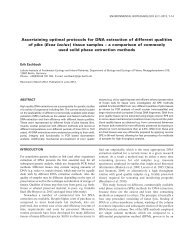Conceptual framework of bioethanol production from lignocellulose ...
Conceptual framework of bioethanol production from lignocellulose ...
Conceptual framework of bioethanol production from lignocellulose ...
You also want an ePaper? Increase the reach of your titles
YUMPU automatically turns print PDFs into web optimized ePapers that Google loves.
16 ENVIRONMENTAL BIOTECHNOLOGY 8 (1) 2012biomass cannot be renewed and used so fast (Gołaszewski2009a). The percentage share <strong>of</strong> biomass in the renewableenergy consumption is estimated to change globally <strong>from</strong> theexisting 77% into 52% in 2040 but at the same time the bi<strong>of</strong>uel<strong>production</strong> efficiency will rise (EREC 2004). The biomassaccounting for approximately 10% in the mix <strong>of</strong> the primaryenergy sources now, will constitute approximately 30% in 2050(Macqueen and Korhaliller 2011).In the future the prospective biomass is indicated to besourced out <strong>from</strong> woody crops <strong>of</strong> short, 2-4-year rotation(mainly willow and poplar), that is vegetative forest stand(SRC – Short Rotation Coppice, SRWC – Short RotationWoody Crops), agricultural <strong>production</strong> and food industry<strong>lignocellulose</strong> waste as well as forestry (SRF – Short RotationForestry) that enjoy optimal fuel parameters upon the lapse<strong>of</strong> 8-15 years (e.g. Stolarski et al. 2009; Weih 2008). Thetendency <strong>of</strong> assigning agricultural land to tree crops isstrongly supported in Sweden, and also in Great Britain,Spain and the USA launched research programmes in thatrespect (Kumar 2009; Rowe et al. 2009). The subject <strong>of</strong> theresearch includes forest stand <strong>of</strong> relatively fast renewablepotential, namely alder-tree, ash-tree, beech, birch,eucalyptus, poplar, willow, maple-tree (Acer pseudoplatanusL.), mulberry-tree (Broussonetia papyrifera), great maple,Paulownia, acacia, and others. According to Berndes andfollowers (2003) and the International Energy Agency (2004)in 2025 <strong>lignocellulose</strong>-based energy is estimated to accountfor as much as 2/3 <strong>of</strong> biomass energy <strong>production</strong>, and theeffective conversion <strong>of</strong> <strong>lignocellulose</strong> into ethanol is going tobe the essential technology for bi<strong>of</strong>uel <strong>production</strong>. Thus,<strong>from</strong> the agricultural point <strong>of</strong> view, <strong>from</strong> among manycurrently developed bi<strong>of</strong>uel and ecopower technologies,technological arrangements for <strong>lignocellulose</strong> biomass-based<strong>production</strong> <strong>of</strong> ethanol will be particularly important in a shorttime perspective as those specific technological arrangementsconstitute an intermediary stage in the process <strong>of</strong> developingintegrated processes <strong>of</strong> converting biomass to an universalenergy medium – hydrogen or electric current.Development <strong>of</strong> the bi<strong>of</strong>uel market according to thescenario exhibited in Figure 1 will boost continual researchon mechanisms driving biological processes and knowledgetransfer for the purpose <strong>of</strong> developing technologies forbioenergy <strong>production</strong>, bi<strong>of</strong>uel <strong>production</strong> and other bioproducts<strong>production</strong> (bioeconomics). Agricultural biorefinery oragrirefinery processing agricultural resources, producing awide spectrum <strong>of</strong> power products and non-power productsmay be the key element for the bi<strong>of</strong>uel market. Thebiorefinery altogether with power generators will make upthe so called agripower compound – a local power cell withinthe system <strong>of</strong> dispersed sources <strong>of</strong> energy consumed locally(Gołaszewski 2009b). It is plausible to state that theagrirefinery will locally integrate three fundamental factors<strong>of</strong> economic sustainable development in rural areas –bioeconomics, environment and society, and implementation<strong>of</strong> this system will directly contribute to sustainabledevelopment and energetic safety <strong>of</strong> the state.Figure 1. Biorefineries and bi<strong>of</strong>uel generations developmentscenario.Biorefinery, 1 st Phase – 1 st generation bi<strong>of</strong>uel made <strong>from</strong> sugarcrops, starch crops, and vegetable oil. In the past ten years:• Upgrade <strong>of</strong> existing 1st generation bi<strong>of</strong>uel <strong>production</strong>technologies.• Research on improvement <strong>of</strong> technological efficiency for<strong>production</strong> <strong>of</strong> 2 nd generation bi<strong>of</strong>uel; biorefineryconceptual <strong>framework</strong> development; pilot installationsfor 2 nd generation bi<strong>of</strong>uel <strong>production</strong> were built –commercialization is in process.Biorefinery, 2 nd Phase – 2 nd generation bi<strong>of</strong>uel:• 2 nd generation bi<strong>of</strong>uel <strong>production</strong> technology development.• Universal character <strong>of</strong> commercial biorefinery, the basicproduct <strong>of</strong> which will be bi<strong>of</strong>uel; research is continued onimprovement <strong>of</strong> <strong>production</strong> efficiency for bi<strong>of</strong>uel made<strong>from</strong> <strong>lignocellulose</strong>-based bi<strong>of</strong>uel and integration <strong>of</strong>biorefining processes and power generation processes.• Power crops development (new biological diversity <strong>of</strong>plants emerging <strong>from</strong> molecular biology engineering, newcrops technologies) within the context <strong>of</strong> agriculturalsustainable development.Integrated Biorefinery, 3 rd Phase – integrated biorefiningprocesses and power generation processes:• Power products (including universal bi<strong>of</strong>uel – methanol) andnon-power products, dispersed agripower compounds.Universal Energy Medium Market – (bio)hydrogen, electriccurrent.Given the current state-<strong>of</strong>-the-art <strong>of</strong> development <strong>of</strong>bi<strong>of</strong>uel <strong>production</strong> technology and existing systems <strong>of</strong> bi<strong>of</strong>uel<strong>production</strong> and distribution, improvement <strong>of</strong> <strong>production</strong>efficiency for <strong>bioethanol</strong> made <strong>from</strong> woody crops – thenatural resource that is available in large quantities and isproduced locally – is challenging today. Bioethanol, as a fuelfor motor vehicles has been produced, for tens <strong>of</strong> years, <strong>from</strong>the natural resource such as crop that is rich in sugar (sugarcane, sugar beet) or starch (grains, potato crops), is 1 stgeneration bi<strong>of</strong>uel. Characteristic feature <strong>of</strong> 1 st generation


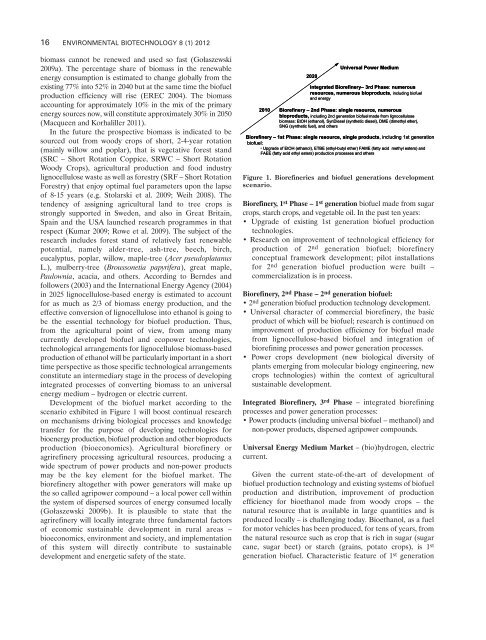
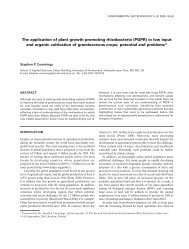
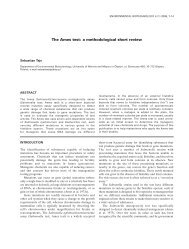
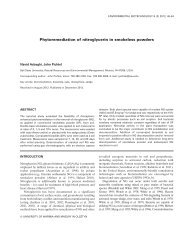

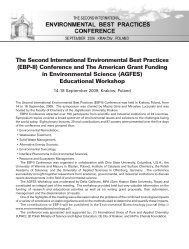
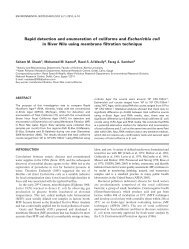
![Genotoxicity of cyclopentha[c]phenanthrene and its two derivatives ...](https://img.yumpu.com/31321772/1/190x249/genotoxicity-of-cyclopenthacphenanthrene-and-its-two-derivatives-.jpg?quality=85)
